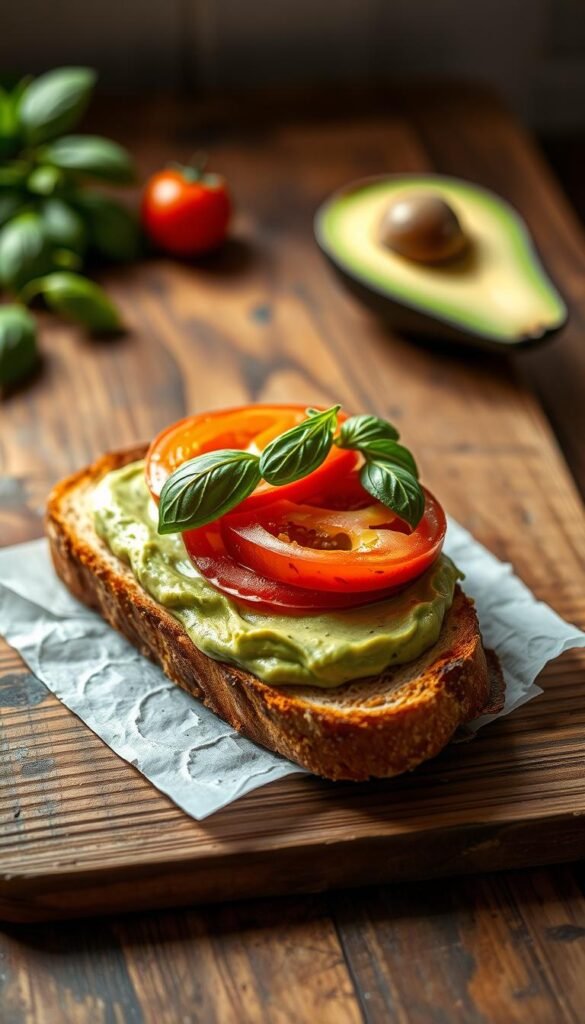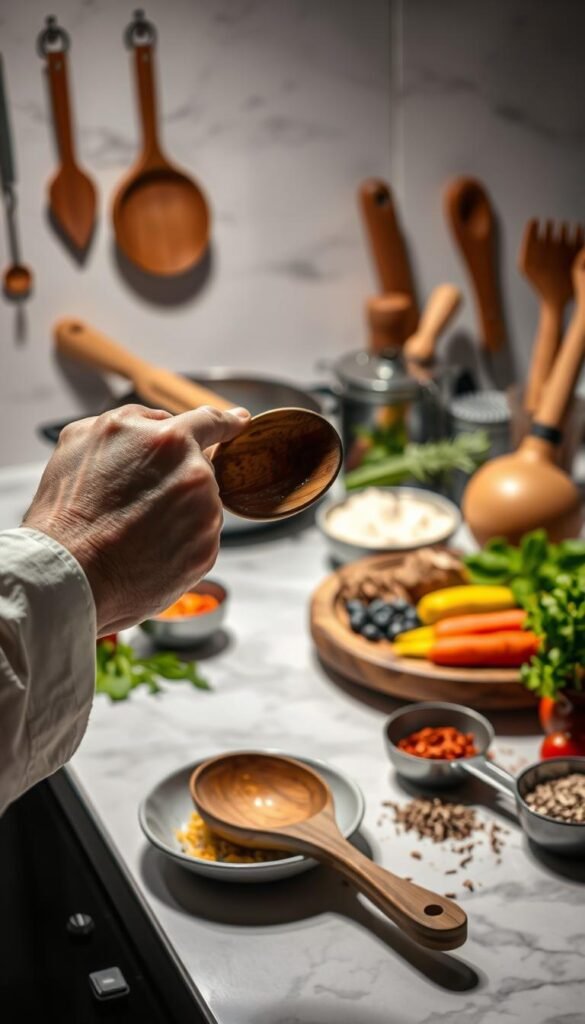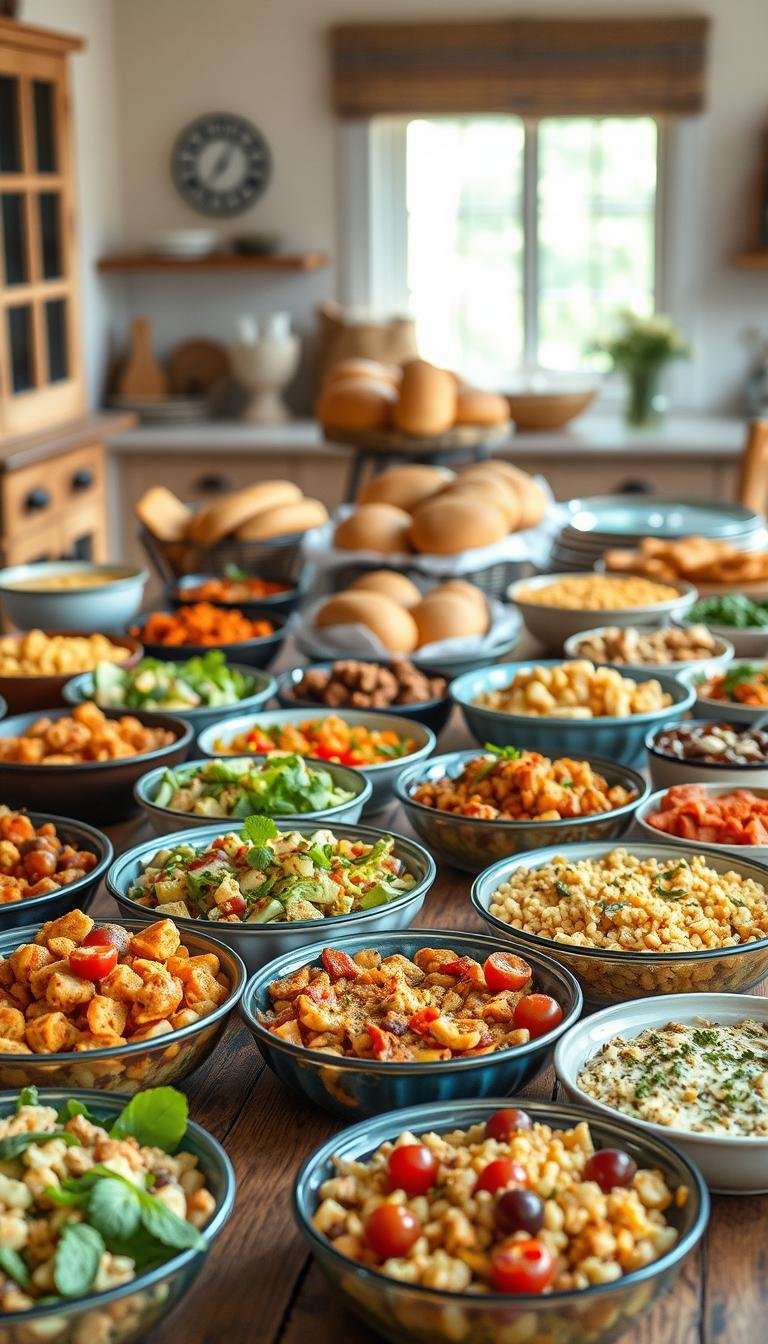Easy Dinner Recipes for One: Quick & Delicious Options
Surprising fact: the 18-minute sketch “Dinner for One” mirrors a real-life rhythm — many solo meals now wrap in under 20 minutes.
This guide curates compact meal ideas that respect your time and keep cleanup light. Expect skillet sears, quick pastas, and rice bowls that hit the table fast.
We highlight smart tools — a sharp chef’s knife, a sturdy cutting board, nonstick and cast-iron pans, and a large pot — so you nail texture and flavor with minimal fuss.
Alongside single-serving techniques, you’ll get scaling tips, pantry-friendly ingredients, and speed benchmarks like pesto risotto in about 18 minutes or salmon in roughly 20 minutes.
Read on to build a personal playbook of solo-friendly dishes that save time and avoid waste while delivering big taste.
Key Takeaways
- Focus on quick-cook ideas that finish in about 20 minutes.
- Use essential tools to simplify technique and improve results.
- Turn pantry MVPs into a full meal with few ingredients.
- Apply scaling tips to prep only what you’ll eat and cut waste.
- Follow timing benchmarks to fit cooking into busy evenings.
- Use bold seasoning choices to boost flavor with minimal steps.
Why Cooking Dinner for One Is Worth It Right Now
Cooking a single plate is a practical way to control portions and cut food waste. You buy and use only the ingredients you need, which saves money and fridge space.
Making a solo meal can also be a quiet ritual after a long day. It helps you unwind and focus on flavor, not cleanup.
Practically, small-batch cooking speeds skill growth. You hone timing, knife work, and seasoning when you cook for yourself. Eric Kim notes that single servings scale up more easily than shrinking family-sized dishes.
| Benefit | Why it helps | Quick tip |
|---|---|---|
| Portion control | Less waste, fresher plates | Measure once; plate once |
| Skill building | Practice heat and seasoning | Cook familiar dishes with small changes |
| Budget-friendly | Buy fewer items, use pantry staples | Rotate flavors each day |
“Single-serving dishes are easier to scale up than scale down.”
Pantry Staples That Power Easy Solo Meals
A focused set of shelf-stable ingredients lets you pivot between cuisines without a big grocery run. Keep things lean and versatile so a single pan or pot can produce a satisfying plate.
Build the base: stock pasta and rice, canned tomatoes, tuna, and tofu. These pantry staples portion well and transform into dozens of meals.
Essential proteins and bases
- Small-format proteins: shrimp, salmon portions, a single chicken breast, or a steak portion cook fast and deliver big flavor.
- Canned tuna and tofu act as quick protein swaps that soak up sauces and dressings.
- White rice and pasta cover comforting carbs; keep both on hand to change textures quickly.
Flavor boosters that matter
- Garlic and onion form the aromatic backbone—mince and store in small jars.
- Butter, soy sauce, red pepper flakes, and a squeeze of lemon lift simple ingredients into bright dishes.
- Canned tomatoes and pantry oils let you build sauces or quick braises within minutes.
“A compact pantry plus a couple of solid pans replaces a full grocery aisle when time is tight.”
Easy Dinner Recipes for One
High heat, sharp seasoning, and a few pantry staples unlock big taste in very little time. These three plates show how to cook fast without losing balance. Each uses minimal gear and finishes with a bright fat or acid to lift flavors.
Sheet-pan shrimp scampi with garlic, butter, lemon, and pepper flakes
Spread peeled shrimp on a hot sheet pan so the edges caramelize. Toss with garlic, red pepper flakes, a splash of soy and mirin, then roast at high heat.
Finish with butter and a squeeze of lemon to make a glossy, bright sauce. Serve with crusty bread or rice.
Buffalo-glazed salmon with blue cheese kale salad
Glaze a single salmon fillet with a tangy buffalo mix and roast or broil. The fillet is ready in about 20 minutes from start to table.
Blue cheese kale salad stands up to the warm fish and adds crunch and cream without extra cooking.
Five-minute skillet steak with fish sauce–lime butter
Heat a skillet until it smokes lightly, then sear a small steak for a minute per side for medium-rare. Turn on the range hood before you start.
Top the steak with fish sauce–lime butter to melt into a glossy pan sauce. Rest briefly and slice against the grain.
- Portion by piece: single fillet, a handful of shrimp, or one steak.
- Minimal cookware: one sheet pan or one skillet keeps cleanup fast.
- Ventilation on: quick sears create smoke—use high hood settings.
| Dish | Cookware | Key lift | Time |
|---|---|---|---|
| Shrimp scampi | Sheet pan | Butter + lemon | 10–12 minutes |
| Buffalo salmon | Baking sheet or broiler | Blue cheese kale | About 20 minutes |
| Skillet steak | Heavy skillet | Fish sauce–lime butter | 5 minutes (plus rest) |
“Roast or sear at high heat, finish with acid and fat, and you get restaurant-level flavor with minimal effort.”
Big-Salad Energy: Meal Salads That Eat Like Dinner
A meal salad should feel like a full course—hearty, bright, and built to satisfy. Focus on bold proteins, layered textures, and a punchy dressing to make a bowl that fills you up.
Cobb with chicken, bacon, egg, blue cheese, and tomatoes
Eric Kim’s Cobb piles cooked chicken, crisp bacon, soft-boiled egg, blue cheese, cherry tomatoes, avocado, and radicchio. A malt vinaigrette cuts the richness and brightens each forkful.
Compose components deliberately: warm protein next to cool avocado and crunchy radicchio so each bite has contrast. Prep a single chicken breast ahead to save time through the week.
Romaine Caesar with roasted seaweed and anchovy
This variation uses one romaine heart, an anchovy-heavy dressing, a splash of sesame oil, and roasted seaweed snacks for umami crunch. The seaweed replaces croutons and adds savory texture without extra cooking.
| Salad | Key ingredients | Why it eats like a main |
|---|---|---|
| Cobb | Chicken, bacon, egg, cheese, tomatoes | High-protein mix and malt vinaigrette balance fat and acid |
| Seaweed Caesar | Romaine, anchovy dressing, sesame oil, roasted seaweed | Salty depth and crispness replace carbs and feel filling |
“Layer textures and temperatures so the salad reads as a full meal.”
Skillet Stars: One-Pan Dinners With Maximum Flavor
A single hot skillet can concentrate flavor, caramelize edges, and finish a full plate in under half an hour. These plates use high heat, quick turns, and bright finishes so you get contrast without extra pans.
Skillet bibimbap with crispy rice, egg, veggies, and gochujang
Heat a cast-iron skillet until it smokes lightly to develop a crispy rice crust that mimics dolsot. Layer warmed rice, quick-sautéed vegetables, and a spoon of gochujang.
Crown the bowl with a runny egg. Finish with a drizzle of sesame oil and a pinch of toasted nori.
Chicken breast with broccoli panzanella and lemony olive oil
Season a single chicken breast and sear it in the same pan you toast cubed day-old bread. Toss the bread with steamed broccoli and a bright lemon-olive oil so it soaks up the pan juices.
This keeps the plate compact: protein, veg, and soaked bread all in one skillet without extra bowls.
Pan-fried lamb chops with minted pea salad
Sear lamb chops at very high heat for 1–2 minutes per side to lock in juices and create a charred edge. Rest briefly, then deglaze with a knob of butter or a splash of lemon to pull a quick glaze.
Serve with a minted pea salad to cut the richness and add freshness.
- Tip: Avoid crowding the pan so you preserve sear quality and avoid steaming.
- Tip: Deglaze quickly to gather fond and make a glossy pan sauce.
Sheet Pan, Foil Packets, and No-Fuss Roasts
Use high oven heat and small trays so seafood finishes fast and the pan juices concentrate into real flavor. Sheet pans and foil packets are perfect when you want a high-impact plate with low cleanup.
Foil-packet scallops with caper-raisin butter take inspiration from Jean-Georges Vongerichten. The caper-raisin compound butter melts into the packet, giving scallops a sweet-salty lift while steam keeps them tender.
The same butter also brightens roasted vegetables or a quick pasta toss. Seal packets tightly, use a small tray so juices reduce, and roast hot and fast—just a few minutes—so scallops stay delicate.
Pizza-style mussels with tomato, oregano, and sherry butter sauce
Pizza-style mussels are baked with a buttery sherry sauce, tomato paste, and dried oregano to echo a pizzeria tang. The butter and sherry make a glossy sauce that begs for crusty bread to mop every drop.
- Why it works: foil and sheet methods trap flavor, cut mess, and make single portions feel special.
- Timing: aim for hot-and-fast minutes in the oven to preserve seafood tenderness.
- Swap ideas: swap in clams, a white fish fillet, or shrimp to use the same base technique.
| Method | Main Flavor Lift | Best Tray Size | Approx. Oven Minutes |
|---|---|---|---|
| Foil-packet scallops | Caper-raisin butter | Small packet on tray | 6–8 minutes |
| Pizza-style mussels | Sherry-butter + tomato paste | Shallow baking dish | 8–10 minutes |
| Sheet pan roast (mixed seafood) | Compound butter or herb oil | Small rimmed sheet | 7–12 minutes |
“Crusty bread is your best friend for catching every drop of buttery sauce.”
Pasta Night for One: Fast Noodles, Big Flavor
Simple noodles can feel celebratory when you focus on texture, acid, and a finishing fat. These quick plates teach three small techniques that upgrade pantry staples into satisfying bowls.
Ketchup spaghetti with butter, onions, and red pepper
Think Napolitan: caramelize ketchup with butter, thin-sliced onion, and red pepper. The pan heat deepens the ketchup into a tomato-like base with bright savory notes.
Fettuccine Alfredo with butter, cheese, and silky sauce
True Alfredo is pasta, butter, and cheese emulsified with starchy water. Toss off heat so the sauce clings and stays glossy.
Spaghetti with fried eggs, garlic, pangrattato, and lemon
Fry an egg until edges crisp. Add toasted pangrattato and a squeeze of lemon to cut the richness. A little garlic in the oil ties the flavors together.
Miso-eggplant spaghetti for umami comfort
Fry cubed eggplant, stir in white miso and a splash of oil. Toss with hot noodles so the miso melts into a savory coating.
- Portion: 3–4 ounces dry pasta per serving.
- Tip: Reserve pasta water to adjust sauce sheen and texture.
- Rotate shapes: spaghetti, fettuccine, or short cuts change the mouthfeel.
- Timing: these dishes come together in minutes and teach reusable technique.
“Small tricks—caramelize, emulsify, crisp—turn pantry items into a memorable dish.”
Have a Rice Day: Comforting Bowls and Risotto
A warm bowl of rice can be the fastest route to comfort when you focus on timing and bright finishes. Small-batch technique turns short-grain rice into a silky base that sings with a vivid lift.
Pesto risotto with shrimp — done in about 18 minutes
Stir pesto into a quick risotto for bright herbal creaminess in about 18 minutes. Fold in a handful of shrimp near the end so they stay tender and juicy.
Risotto alla carbonara with bacon, egg, and Parmesan
Carbonara risotto borrows from Rome: bacon and a whipped egg bind the grains into a silky finish. Think of swapping pasta technique for rice starch to reach that same glossy texture.
Seasoned salmon over warm sushi rice with soy vinaigrette
Seasoned salmon pairs perfectly with warm sushi rice and a versatile soy vinaigrette. That sauce doubles as a weekly dressing you can reuse across proteins and vegetables.
- Rinse and cook short-grain rice for optimal texture in single portions.
- Keep heat moderate and add liquid gradually to control starch release.
- A small pot or sauté pan is plenty for a single-serving risotto.
- Adjust seasoning at the end; the finish should be glossy, not heavy.
- Top the bowl with quick-pickled veg or sesame seeds for crunch.
| Dish | Key lift | Cookware | Approx. minutes |
|---|---|---|---|
| Pesto risotto with shrimp | Pesto + finish butter | Small pan | 18 minutes |
| Carbonara-style risotto | Egg + bacon | Small pot | 15–20 minutes |
| Seasoned salmon bowl | Soy vinaigrette | Small bowl & pan | 10–15 minutes |
“Rice bowls bring comfort with efficient technique and minimal waste.”
Chicken, Steak, and More Protein-Forward Dinners
Start with a single protein and build contrast—crisp crust, tender interior, and a bright sauce. These plates focus on decisive technique so each element finishes in a short span and reads like a full meal.
Honey-mustard chicken breast with corn panzanella
Bake a single chicken breast brushed with honey-mustard until it’s just cooked. Rest it briefly so juices redistribute.
Make a raw corn panzanella by tossing kernels, chopped herbs, tomatoes, and torn day-old bread dressed with lemon and oil. The soaked bread becomes tender and soaks up pan juices.
Chicken-fried steak katsu with creamy milk gravy
For the katsu, shallow-fry a small cutlet until golden and crisp. Use a wire rack to drain and keep the crust crisp while you make a quick milk sauce.
Whisk pan drippings with milk and a pinch of nutmeg to create a creamy gravy. Keep frying shallow and controlled so the process is tidy and the steak cooks evenly.
- Single-serving proteins reduce guesswork and finish faster.
- Let fried cutlets rest on a rack to stay crisp.
- Finish both plates with a squeeze of acid or a spoon of gravy to tie the dish together in a few minutes.
“A brief rest after cooking locks in juices and keeps the plate tender.”
Seafood in Minutes: Salmon, Shrimp, and Scallops
A hot oven and a short timeline turn seafood into a glossy, restaurant-style plate. These methods focus on quick heat, confident seasoning, and a bright finish so seafood stays tender and vivid.
Garlic shrimp baked hot and fast with butter and lemon
Blast shrimp at high temperature so they caramelize in their own juices. Finish with minced garlic, a knob of butter, and a squeeze of lemon to cut richness and add sparkle.
Use a small pan so the cook time stays short and even. In a few minutes the shrimp will be opaque, glossy, and ready to serve with a grain or quick salad.
Blue cheese-buffalo salmon with a crunchy kale side
Brush a single fillet with a buffalo glaze and roast until it flakes easily—about 18–20 minutes. Crumble a little blue cheese over sautéed kale to cool the heat and add savory depth.
Finish the fish with a spoon of warm pan sauce to add sheen and seasoning. Adjust spice levels to taste and top with herbs or lemon zest for lift.
- Blast shrimp in a hot oven to concentrate juices; finish with garlic, butter, and lemon.
- Use a small pan for quick, even cooking of single portions.
- Keep frozen portions on hand so seafood is always within reach.
- Pair with a simple grain or salad to make a balanced plate quickly.
| Dish | Main Finish | Cook Time |
|---|---|---|
| Garlic shrimp scampi | Butter + lemon | 6–8 minutes |
| Buffalo-glazed salmon | Blue cheese + kale | 18–20 minutes |
| Scallop foil packet | Caper butter | 6–9 minutes |
“Cook seafood quickly and finish with acid or fat to keep flavors bright and textures perfect.”
Vegetarian and Tofu Favorites Packed With Protein
Plant-forward cooking shines when texture, acid, and a confident glaze come together in minutes. These two plates show how firm tofu and fast vegetables can make a full, satisfying plate without fuss.
Sweet-and-sour tofu with pineapple, red pepper, and onion
Press firm tofu lightly, cube it, and pan-sear until golden. Toss the crisp cubes with pineapple, sliced red pepper, and onion in a tangy sweet-and-sour mix so the fruit balances the acid.
Build the stir-fry in a small pan to avoid crowding. Keep the sauce bright so each bite feels lively and fresh.
Paper-thin asparagus with butter-soy glaze over rice
Slice asparagus paper-thin and flash-cook in a hot pan. Add a two-ingredient glaze of butter and soy; it melts into a glossy coat in about two minutes.
Spoon the asparagus over warm rice to turn the veg into a complete plate that pairs well with the tofu.
- Use firm tofu so cubes hold shape and absorb flavors.
- Keep sauces balanced—sweetness should support acidity.
- Adjust heat with chili or ginger if you want a kick.
- Finish with scallions or sesame for a clean, nutty accent.
“Crisp textures and bright sauces make vegetarian plates feel intentional, not secondary.”
Tip: Choose quality ingredients and press the tofu briefly to speed browning. These small steps turn simple components into a protein-packed dish that satisfies without extra steps.
Sandwiches, Toasts, and Open-Face Dinners
Sandwiches and toasts can turn pantry staples into a satisfying plated meal with no stove needed. These builds work when you want something fast, filling, and flavorful. They rely on texture and careful seasoning more than long cooking.

Japanese convenience-store style egg salad sandwich
Make a conbini-style egg salad sandwich using super-smooth filling and pillowy white bread. Mash the boiled egg with plenty of mayo, a pinch of salt, and a touch of mustard until silky.
Use thick, soft bread slices and assemble gently so the filling stays airy. A slice of cheese or crisp lettuce adds contrast and richness without overpowering the texture.
Nori and sesame avocado toast with seaweed snack
For a savory toast, mash avocado with sesame oil and a crumbled roasted seaweed snack. Add salt and a squeeze of lemon to lift the umami and keep the topping bright.
These toasts are ideal when the stove stays off. They also make a smart home for leftover proteins, herbs, or pickled veg when you want a quick, satisfying food option.
- Season deliberately: silky texture matters as much as flavor.
- Assemble to order: prevents sogginess and preserves crunch.
- Choose sturdy slices: toast that holds toppings but stays tender to the tooth.
| Build | Main components | Why it works |
|---|---|---|
| Egg salad sandwich | Silky egg mayo, soft bread, optional cheese | Ultra-smooth filling + tender bread for signature bite |
| Nori sesame avocado toast | Avocado, roasted seaweed snack, sesame oil | Umami crunch with bright, nutty finish |
| Open-face protein toast | Leftover protein, herbs, crisp veg | Quick assembly, balanced texture, no-cook warmth |
“Small changes in texture and seasoning make simple sandwiches feel deliberate and full.”
Soups, Bowls, and Cozy One-Pot Options
A compact pot can convert humble ingredients into a restorative bowl that lands in minutes.
Cornish game hen soup yields a fortified broth when simmered slowly with garlic, ginger, and onion. The broth is rich but light enough to feel restorative after a long day.
Crisp fried shallots add crunch and savory depth to each serving. Finish the bowl with herbs and a squeeze of citrus to cut the fat.
Cornish game hen soup with garlic, ginger, and fried shallots
Simmer a small hen in water with aromatics until the stock tastes concentrated. Strain, return a ladle of liquid, add quick vegetables, and top with fried shallots.
Quick noodle bowls and microwave omelets for busy weeknights
Stock shelf-stable noodles so you can assemble a hot dish in under 10 minutes. Layer hot broth, cooked noodles, greens, and a soft egg for a fast, balanced bowl.
A microwave omelet takes only a few minutes to prep and cook. Add vegetables, herbs, and cheese to adapt it to what you have on hand.
- Simmer a small hen to make an aromatic broth with garlic and ginger.
- Build noodle bowls in minutes by layering broth, noodles, and greens.
- Use a single pot to keep cleanup simple and make solo cooking feel effortless.
| Option | Main lift | Rough time |
|---|---|---|
| Cornish game hen soup | Garlic + ginger broth, fried shallots | 60–90 minutes (stock) / 15 minutes (reuse) |
| Quick noodle bowl | Broth + shelf noodles + egg | Under 10 minutes |
| Microwave omelet | Veggies + cheese | 2–4 minutes |
“A single pot and good aromatics turn pantry items into nourishing food.”
Ready in Under 30 Minutes: When Time Is Tight
When the clock is tight, choose techniques that prioritize speed and clear flavor wins. These approaches let you plate a satisfying meal in under 30 minutes without sacrificing texture or seasoning.
Quick prep and high heat are the backbone of these dishes. Mise en place matters: chop veg, measure sauce ingredients, and have starches boiling so elements finish together.
Stir-fries with shrimp or broccoli, plenty of garlic and chili flakes
Sear shrimp at high heat or flash-toss broccoli with a bit of oil so edges char while centers stay crisp-tender.
Add minced garlic and chili flakes near the end to avoid burning and to keep aromas bright. A splash of soy or citrus makes an instant sauce.
One-pot noodles or pasta using pantry staples and cheese
One-pot pasta turns starch into sauce quickly. Boiling pasta in milk concentrates starch and gives a creamy finish without extra steps.
Stir in grated cheese off the heat, then fold in a knob of butter or a spoonful of soy to balance richness. This method is forgiving and ideal for solo cooking.
- Timing tip: cook starch so sauce and protein land at the same moment.
- Prep tip: keep vegetables prepped to preserve crisp-tender texture.
- Sauce ideas: butter, soy, or a squeeze of citrus lift simple pans.
- Rotate: swap proteins and veg across the week to keep the formula fresh.
| Quick Meal | Main Technique | Approx. Minutes |
|---|---|---|
| Prawn/cauliflower stir-fry | High-heat toss with garlic and chili | 25 minutes |
| Microwave omelet | Stovetop-free egg + fillings | 3–5 minutes |
| DIY instant noodles with add-ins | Boil and dress with pantry sauce | Under 10 minutes |
| Milk-boiled one-pot mac | Boil pasta in milk; finish with cheese | Up to 30 minutes |
“Momentum in the kitchen beats multi-tasking—set up once, move fast, and finish with a bright lift.”
Make-Ahead and No-Leftover Strategies for Meal One
Plan a little up front and most weeknights will feel solved. A brief batch of prep saves time and keeps portions accurate so food doesn’t hang around uneaten.
Scaling tips: single portions for pasta, rice, and proteins
Measure once: 3–4 oz dry pasta, 1/2–3/4 cup dry rice, and 4–6 oz protein per plate. Batch-prep aromatics, then portion them into small jars so flavor is ready when you need it.
Freeze proteins in individual packs so you defrost only what you plan to eat. Track what works and repeat the best quantities.
Smart use of bread: panzanella, pangrattato, and toast toppings
Old bread becomes panzanella when dressed with lemon and olive oil. Save crumbs to make pangrattato—toast with garlic and herbs and sprinkle on pasta for crunch.
Favor flexible ingredients that move across plates; that’s the clearest way to avoid waste.
| Strategy | What to prep | Benefit |
|---|---|---|
| Measure portions | Pasta, rice, proteins | Less waste, consistent plates |
| Batch aromatics | Garlic, onion, herbs | Faster weeknight cooking |
| Bread reuse | Panzanella, pangrattato, toast | Zero-waste texture and flavor |
“It’s easier to scale single-serving recipes up than to scale family recipes down.”
Pro Tips to Level Up Flavor Fast
A calm mise en place and confident pan work change average plates into standout meals. Read the whole recipe before you begin so you can plan timing and avoid surprises. Measure and chop ingredients first; this keeps the line moving and reduces stress at the stove.

Mise en place: read, chop, and season as you go
Do the small prep steps first: mince garlic, zest lemon, and portion spices. That prep makes tasting and quick adjustments natural.
Taste as you go—a tiny squeeze of acid or a pinch more salt often fixes a flat pan sauce. Clean as you go so plating is the last, easiest step.
Cast-iron and nonstick skillet basics, plus a trusty pot
Use a cast-iron skillet to build a deep sear and fond; use nonstick for eggs and delicate proteins. A good pot handles boiling, simmering, and one-pot meals without fuss.
Manage heat: preheat pans and avoid overcrowding to keep textures crisp. Deglaze the fond with a splash of liquid to make an instant pan sauce, then finish with herbs, butter, or lemon to polish flavor.
- Invest in a sharp chef’s knife and a sturdy cutting board.
- Stock oils, salt, pepper, soy, cornstarch, sugar, and garlic.
- Organize prep so the stove becomes your best way to get big results fast.
“Small, deliberate moves at the stove deliver the most dramatic flavor gains.”
Conclusion
Treat solo meals as a daily habit. Small, steady steps—brief prep, the right tools, and bold finishing touches—make cooking feel reliable and satisfying.
Use the techniques in this guide to build a rotation: salads, skillet plates, sheet pan meals, pasta, and rice bowls. Scale portions precisely so you cook just enough and avoid waste.
With pantry planning and a few go-to moves, you can plate satisfying dinners in minutes. Return to these recipes when your schedule is tight. One cook, one pan, one great meal—night after night.






